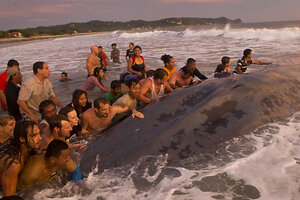Valiant effort to save blue whale stranded on Nicaragua beach
Nicaraguan residents and tourists worked throughout the day Friday to rescue a 60-foot blue whale stuck on a beach.

Residents and tourists push a whale to try to return it to the ocean from Popoyo beach in Rivas, Nicaragua, Friday, Nov. 14, 2014. They were unable to help the beached whale discovered Friday morning.
(AP Photo/Esteban Felix)
More than two dozen tourists and local residents spent many hours Friday trying to get a blue whale, beached on the Nicaragua coast, back into deeper water. But the whale died late Friday evening and was buried with heavy equipment on the beach Saturday morning.
The last time a blue whale found itself stranded on Popoyo Beach, some 30 years ago, the locals cut it up and ate it, recalls Faustino Moraga Chávez, a resident of Rivas, Nicaragua. The inspiring, if ultimately futile, effort to save this 60-foot-long cetacean is indicative of how much attitudes toward the giant creatures have shifted in recent decades.
"I can assure you today nobody is going to eat it because we have more environmental awareness now and we know that we earn more from tourism [with the whales here], Mr. Moraga Chávez told the daily Nicaraguan news outlet, La Prensa.
The National Oceanic and Atmospheric Administration estimates that there are 2,500 blue whales now in the North Pacific. The eastern Pacific stock of blue whales is believed to spend winters off of Mexico and central America, and feed during summer off the US West Coast and, to a lesser extent, in the Gulf of Alaska and central North Pacific waters, according to NOAA.
From the 1890s-1966, blue whales were hunted in all the world's oceans, and their populations were significantly reduced. At least 9,500 blue whales were taken by commercial whalers throughout the North Pacific from 1910-1965 (Ohsumi and Wada, 1972) and at least 11,000 were taken in the North Atlantic from the 1890s-1960s (Sigurjónsson and Gunnlaugsson, 1990).
In 1966, the IWC banned commercial whaling for blue whales and no whaling (neither aboriginal subsistence nor commercial) occurs now. However, illegal whaling for blue whales has been documented or is likely to have occurred.
The biggest threats to blue whales today are being hit by ships or ships propellers and getting caught in fishing nets or gear.
As Reuters has reported, conservation groups say at least 11 blue whales are struck each year along the U.S. West Coast, nearly four times the "potential biological removal" level of 3.1 permitted under the U.S. Marine Mammal Protection Act.
But a marine biologist who inspected Nicaragua's stranded blue whale, couldn't find any obvious signs of injury, reported La Prensa.

